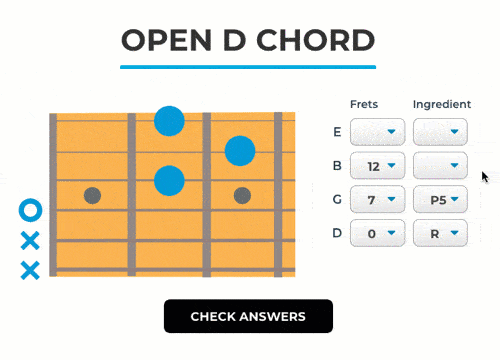CAGED system for Guitar: a Simple 6-Step Guide
We’ve only seen major chords so far, but we can change them into different chord types such as minor chords, minor seventh chords, dominant chords and so on.
Let’s check out an example.
Here’s a D chord, based on the A shape again.

Now, we can change this into a D minor chord (Dm) by changing a single note. All we need to do is lower the B string by one fret.

We can also turn it into a D major seventh chord (Dmaj7), by lowering the G string one fret.

Or we can turn it into a D7 chord, by lowering the A string two frets.

Now, you’re probably wondering: how do I know what strings I need to change?
This is where music theory comes in. We need to know what intervals are, how to play them on guitar and how chords are constructed.
Before we explore this further though, if you’re completely new to changing chord shapes, please don’t worry about the theory behind it yet. Instead, focus on memorising these chord shapes without yet understanding them. Learn the ‘E shape’ barre chords and the ‘A shape’ barre chords, in all sorts of variations. You can have a lot of fun with just 3 or 4 of these barre chord shapes and play lots of songs with them. To find out more about this, check out Guitar Chord Bootcamp: Barre and Beyond.
Now, let’s run through the theory quickly. I won’t go into too much detail in this article on this, but you can read more about it in my article on music theory for guitar.
For this explanation, I’m assuming you already have an understanding of intervals on guitar.
In short: every ‘chord type’ (major, minor, major seventh etc.) has certain ‘chord ingredients’. For example:
- Major chord: R, M3, P5
- Minor chord: R, m3, P5
- Major Seventh chord: R, M3, P5, M7
LEGEND
R = Root
m3 = minor third
M3 = major third
P5 = perfect fifth
M7 = major seventh
To be able to change chord shapes, we need to know not just what the chord shape looks like, but which ‘chord ingredient’ every note is.
For example, here is the D chord again, with the ‘chord ingredients’ indicated:

As you can see, it has the three ingredients that a major chord should have: a root note (R), major third (M3) and a perfect fifth (P5).
The ‘recipe’ for minor chords is slightly different. Instead of a major third (M3) we have a minor third (m3). So, here’s the D minor(Dm) chord with its ‘chord ingredients’:

In short, we can change the shapes by knowing the ‘recipes’ for the chord type we want to create. If we then know where each ‘ingredient’ is located, we can change what we need to change.
If you’re an All Access member, you can get more practice with this in Music Theory from Scratch. It has exercises where you can practice these chord shapes, analysing every single ingredient.

Not a member yet? You can still get started and try the first couple of lessons for free!
Originally posted by Just at https://www.stringkick.com/blog-lessons/caged-system-for-guitar/

